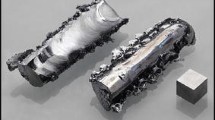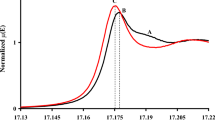Abstract
The experimental data on the joint fluorination of metallic iridium and platinum with molecular fluorine in the temperature range 654–880 K have been analyzed. The reasons for the decrease in the thermodynamic activity of metals and the possibility of the formation of new phases on their surfaces have been quantitatively considered. The ΔrH°(0) of reactions, kJ/mol, have been determined: Ir(c) + PtF4(g) = IrF4(g) + Pt(c), 23.0 ± 4.5; Ir(c) + 2IrF6(g) = 3IrF4(g), 217.7 ± 8.6; Ir2F6(c) + IrF6(g) = 3IrF4(g), 396.2 ± 21.3. The standard enthalpies of formation of the following iridium fluorides have been recommended: ΔfH°(Ir2F6, c, 0) = ‒1012.6 ± 15.5 kJ/mol, ΔfH°(IrF4, g, 0) = –482.3 ± 7.7 kJ/mol, and ΔfH°(IrF6, g, 0) = –832.3 ± 12.7 kJ/mol.

Similar content being viewed by others
REFERENCES
A. V. Dzhalavyan, E. G. Rakov, and A. S. Dudin, Russ. Chem. Rev. 52, 960 (1983). https://doi.org/10.1070/RC1983v052n10ABEH002908
A. A. Bondarenko, Cand. Sci. (Chem.) Dissertation, Moscow, 1987.
A. A. Bondarenko, Extended Abstract of Cand. Sci. (Chem.) Dissertation, Moscow, 1987.
J. B. Mann, J. Chem. Phys. 46, 1646 (1967). https://doi.org/10.1063/1.1840917
A. Tressaud, F. Pintchoovski, L. Lozano, et al., Mater. Res. Bull. 11, 689 (1976). https://doi.org/10.1016/0025-5408(76)90146-X
M. I. Nikitin and E. V. Karpukhina, Russ. J. Inorg. Chem. 52, 475 (2007). https://doi.org/10.1134/s003602360704002x
M. I. Nikitin, Russ. J. Inorg. Chem. 53, 1292 (2008). https://doi.org/10.1134/s0036023608080238
M. V. Korobov, Doctoral Sci. (Chem.) Dissertation, Moscow, 1989.
M. V. Korobov, V. N. Mitkin, and L. N. Sidorov, J. Chem. Thermodyn. 20, 299 (1988).https://doi.org/10.1016/0021-9614(88)90125-5
K. F. Zmbov and J. L. Margrave, J. Inorg. Nucl. Chem. 29, 673 (1967). https://doi.org/10.1016/0022-1902(67)80322-1
State Diagrams of Binary Metal Systems: A Handbook, vols. 1–3, Ed. by N. P. Lyakishev (Mashinostroenie, Moscow, 1996) [in Russian].
M. I. Nikitin and E. N. Karpukhina, Russ. J. Inorg. Chem. 52, 334 (2007). https://doi.org/10.1134/s0036023607030072
O. Ruff and J. Fischer, Z. Anorg. Allg. Chem. 179, 161 (1929). https://doi.org/10.1002/zaac.19291790113
M. Binneweis and E. Milke, Thermochemical Data of Elements and Compounds (2002). https://doi.org/10.1002/9783527618347
E. G. Rakov, A. V. Dzhalavyan, and A. S. Dudin, Proceedigs of II Meetings on Chemistry and Technology of Rare and Trace Elements, Erevan, 1981, p. 93.
Thermal Constants of Substances. A Handbook, vols. 1–10, Ed. by V. P. Glushko, vol. 7, part 1 (VINITI, Moscow, 1974) [in Russian].
G. H. Cady and G. B. Hargreaves, J. Chem. Soc. 1063 (1961). https://doi.org/10.1039/jr9610001568
N. Bartlett and D. H. Lohmann, Proc. Chem. Soc. 115 (1962).
N. Bartlet, Syntheses of Inorganic Compounds, vol. 2 (Mir, Moscow, 1967) [in Russian].
M. I. Nikitin and S. G. Zbezhneva, Russ. High Temp. 50, 186 (2012). https://doi.org/10.1134/S0018151X12020125
C. L. Chernick, H. H. Claasen, and B. Weinstock, J. Am. Chem. Soc. 83, 1365 (1961).
W. A. Sunder and W. E. Falconer, Inorg. Nucl. Chem. Lett. 8, 537 (1972). https://doi.org/10.1016/0020-1650(72)80136-3
P. L. Robinson and G. J. Westland, J. Chem. Soc. 4481 (1956). https://doi.org/10.1039/JR9560004481 .
S. Riedel and M. Kaupp, Chem. Int. Ed. 45, 3708 (2006). https://doi.org/10.1002/anie.200600274
B. A. Maklin and J. Withers, Proceedings of the II International Conference on Chemical Vapor Deposition, Los Angeles, New York, 1970, p. 161.
K. R. Sump and B. D. Howard, Proceedings of the II International Conference on Chemical Vapor Deposition, Los Angeles, New York, 1970, p. 521.
S. V. Kuznetsov, Cand. Sci. (Chem.) Dissertation, Moscow, 1987.
JANAF https://janaf.nist.gov/
Thermodynamic Properties of Individual Substances, Ed. by V. P. Glushko (Nauka, Moscow, 1982) [in Russian].
L. V. Gurvich, Vestn. AN SSSR 3, 54 (1983).
Funding
The study was performed in the framework of the state assignment of IGIC RAS in the field of basic research.
Author information
Authors and Affiliations
Corresponding author
Ethics declarations
CONFLICT OF INTEREST
The authors declare no conflicts of interest.
ADDITIONAL INFORMATION
The thermodynamic functions of gaseous iridium(IV, VI) fluorides are tabulated in [27], but in the present work, the statistical weight of the ground electronic state g0 for IrF4 is replaced by 4, for IrF6 by 6, and for PtF4 by 10. Φ°(IrF5(g), T) is taken the same as for RuF5 [27] with g0 replaced by 5 and a correction for the mass ratio of these molecules is applied.
For crystalline fluorides IrF4 and Ir2F6, estimates were made, as in [5, 7], for the corresponding platinum fluorides. The presented thermodynamic potential of crystalline iridium tetrafluoride Φ°(IrF4(c), T) and its temperature dependence are taken to be similar for ZrF4(c) [28], with allowance for the difference in the Latimer contributions for Zr and Ir (added 13 J/(mol K)). Φ°(Ir2F6(c), T) and its temperature dependence are taken to be the same as for GaF3(c) [29], with allowance for the difference between the Latimer contributions for Ga and Ir (added 16.7 J/(mol K)), and Ф°(Ir2F6(c), T) = 2[Ф°(GaF3(c), T) + 16.7].
For metallic iridium and platinum, the data were taken from [30].
Additional information
Translated by G. Kirakosyan
Rights and permissions
About this article
Cite this article
Nikitin, M.I., Alikhanyan, A.S. Thermochemistry of Iridium Fluorides. Russ. J. Inorg. Chem. 67, 1794–1802 (2022). https://doi.org/10.1134/S0036023622600940
Received:
Revised:
Accepted:
Published:
Issue Date:
DOI: https://doi.org/10.1134/S0036023622600940




